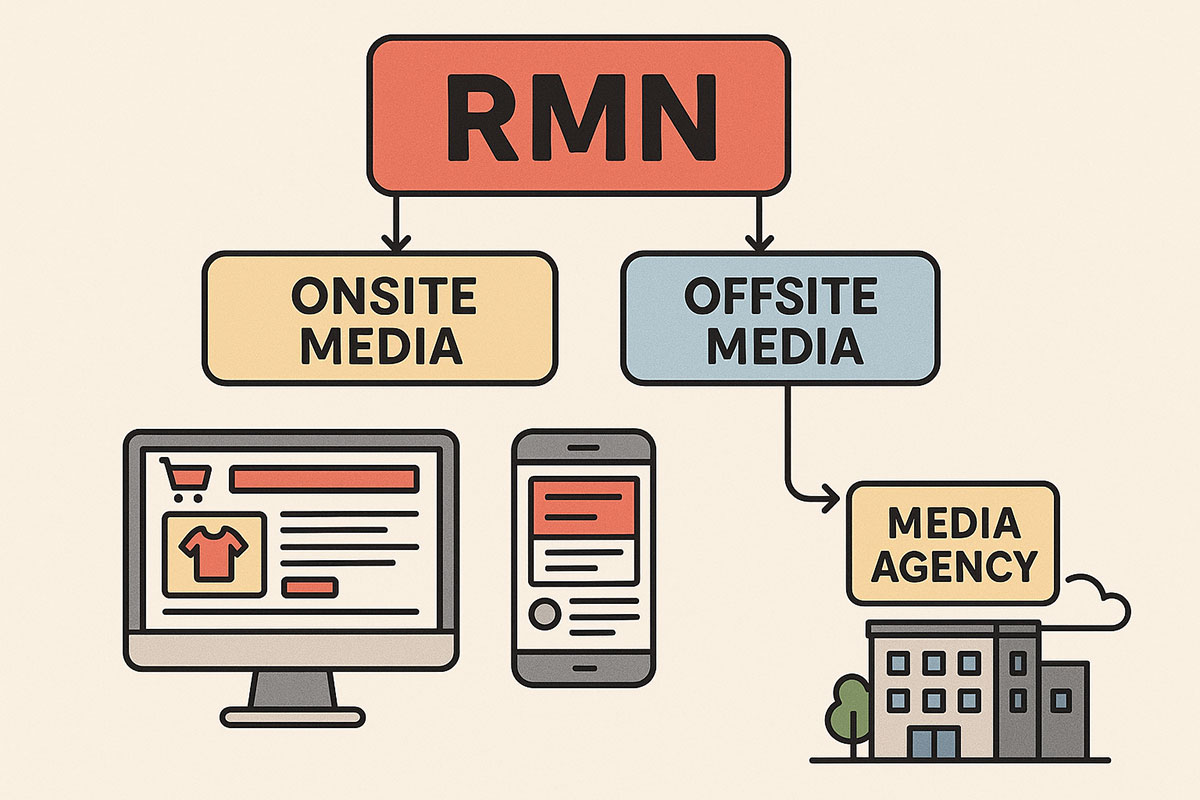Retail Media Networks 101: Why Media Agencies Still Matter

Retail Media Networks (RMNs) are one of the fastest-growing advertising channels today. From sponsored product placements in a grocery store’s app to digital displays in the store itself, RMNs help retailers of all kinds monetize their shopper data, their in-store traffic, and much of their other owned media.
Here’s the rub…RMNs are not a replacement for a skilled media buyer. Instead, RMNs are a high-intent channel that must be a part of a larger paid media strategy to truly pay off. So, before you move your whole budget (and your performance) into an RMN, let’s look at RMNs and how a media agency can add value and help protect your RMN investment.

What is a Retail Media Network (RMN)?
A Retail Media Network is a media sales channel (a platform) owned or operated by the retailer. It sells ad placements directly within their own shopping environment, whether that be in-store or online, and typically extends onto the web. The big plus with a RMN is that it leverages the first-party data of the retailer. Here’s a quick example:
Suppose a pasta sauce brand wants more sales at a specific grocer both in-store and on the grocery shopping app. Here’s how a strategy to reach that goal might work with an RMN:
- Onsite digital ads: Sponsored search placements on the app and the grocery website so that when anyone searches “pasta sauce” their product appears at the top.
- Category banner ads: Banners placed in the “Italian foods” category of the app with their special offer.
- In-store: Endcaps and digital displays can also feature the pasta sauce.
- Offsite audience extension: Using the shopper data, a media buyer can target ads across the open web and social media. For instance, someone who bought pasta at the grocery store recently might see ads for that pasta sauce, potentially prompting a trip. Audience data can also be used to create lookalike audiences with other targeting layers like geography and psychographics to drive in-store traffic or online sales of the pasta sauce through the grocer.

Measurement plays a big role in the power of the RMN and can be incredibly insightful. However, the data must be accessible to the RMN to close the reporting loop completely. In our example, if “units sold” online and in-store isn’t tracked or made available, the reporting is less useful.
Brands love RMN.
And why shouldn’t they? RMNs combine the precision of digital targeting with the immediacy of point of purchase timing. Ads reach shoppers when they are most likely to buy, and with reporting like we described above, impressions can be tied directly to sales. It’s precise targeting combined with better ROI. What’s not to love from a brand perspective?!
For retailers, Retail Media Networks can unlock a high-margin revenue stream. Brands want premium placement inside the retailer ecosystem and will pay a premium price to get in front of shoppers. The retailer keeps the lion’s share of that buy.
But, and you knew there was a but…
RMNs are most often a walled garden. Super great at what’s inside the garden, but out of touch with the rest of the media ecosystem. This is where a skilled media buyer and paid media ensures that when a retailer invests in an RMN, it’s part of a bigger more profitable picture.
The media buyer advantage in an RMN world
Retail Media Networks are becoming a must-have channel for brands, and the role the media agency plays has never been more critical. RMNs excel at reaching shoppers who are buying, right now. It’s fantastic at tying ad spend directly to sales (if the reporting is supported properly). They are incredibly powerful, but quite often isolated from the broader marketing of the retailer. A media agency bridges that gap. They manage budget allocation, align creative across touchpoints, and unify performance measurement. With a skilled media agency, a RMN is transformed from a single-channel tactic into a high performing element of an integrated media strategy. Here’s how.
It’s all about the full funnel
An RMN hangs out at the purchase stage, but the journey to making a purchase starts long before that. A media agency aligns your RMN spend with awareness and consideration channels to warm up the audience.
- Awareness – CTV, Paid Social, Display, OOH – These drive traffic to the ecosystem so the RMN can take over.
- Consideration – Search, Retargeting – These channels identify and nurture shopper intent.
- RMN – Closes the sale.
Optimize that budget
RMNs can be cannibalistic. They take budget from trade marketing, shopper marketing, or digital media, oftentimes with zero oversight resulting in an unbalanced mix. Overly focusing on the high-margin onsite buys seems like a good idea, until you’re not spending on bringing in net new customers and hit a plateau or worse, a decline. By contrast, a media agency:
- Tests and reallocates budget based on overall system performance including those important offsite paid channels.
- Allows retailers to measure whether RMN sales are “net new” or simply shifting from other channels and purchases.
- Prevents over investment in a single channel. You know, all the eggs in one basket and if something happens to that basket…
Audience Extension
Most RMNs offer some sort of audience extension. This is where shoppers are targeted before they arrive at the retailer’s site or store. Media agencies are better positioned for audience extension than an RMN because they operate with a wider lens, more tools, and fewer constraints than a single network. Cross-channel strategies are designed by agencies so:
- Offsite media warms up the audience with placements on social, OTT, and programmatic
- Messaging is consistent at every step, building trust and confidence with the shopper
- RMN ads seal the deal
Speaking of messaging…
A media agency can turn RMN creative from “good enough” to “can’t miss”. Retailers provide the placement, but often it’s the media agency that shapes the story. Brand messaging that feels native in the retail environment while staying consistent with wider campaigns is not a nice to have, it’s a must.
- Creative should align with shopper behavior in that retailer’s environment
- Offers, imagery, and copy are consistent but tailored for conversion at the point of purchase
- Testing in the wider offsite environment informs messaging and creative inside the walled garden

The Bottom Line
That’s where a skilled media agency makes a difference, making sure your RMN spend doesn’t sit in a silo. A solid agency will connect your RMN to a broader paid media strategy, align creative and messaging, and manage sequencing so every shopper interaction works in harmony.
The result is an RMN that’s more than an ad platform. It’s an engine that drives sales, strengthens loyalty, and maximizes ROI. With the right media strategy, your RMN investment isn’t just profitable, it’s transformative.


